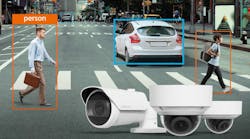VANCOUVER, British Columbia -- Video surveillance technology is arming law enforcement authorities with powerful new capabilities, quickly making video surveillance the "third forensic" alongside fingerprints and DNA. After the recent arrest of Juan Covington for the sidewalk slaying of hospital technician Patricia McDermott, Philadelphia District Attorney Lynn Abraham emphasized the importance of "great surveillance cameras" in solving the case.
Patricia McDermott, a mother of two, was murdered in the dark while the streets of Philadelphia were quiet. Without any human witnesses, the police would have had very little to work with had a special night vision camera not been previously installed by the Department of Homeland Security (DHS) for a nearby federal government building.
Despite the dark lighting conditions that would likely render human eyewitness accounts unreliable, the "great surveillance camera" incorporated active-infrared night vision technology. The technology, manufactured by Canadian / British firm Extreme CCTV and previously deployed by organizations ranging from the US Air Force to anti-terrorist police in London, uses "invisible" infrared illumination to make dark night-time scenes appear as if it were day. The captured images acted as key critical evidence, which kept the case alive, according to District Attorney Abraham. As one police officer said, "those are the best surveillance videos we have ever seen."
Further abroad, active-infrared has helped authorities in the London Terror investigations, allowing them to review video from Underground tunnels, despite apparent darkness. Active-infrared technology even enables the Metropolitan Police to examine license plate data, either as part of an investigation or as a counter-terrorism measure against car bombings. To quote London Mayor Ken Livingstone, "We were able to identify these people (the suspects) so quickly because of the scale of investment we made in close-circuit television."
As both investigations continue, video surveillance technology is clearly showing its value as an investigative tool.
Credit for success in the Philadelphia case should go not only to the detectives and the tipsters, but also to the DHS. In additional to making their surveillance videos immediately available to the Philadelphia police, the DHS surveillance experts also selected Extreme CCTV's EX82 camera for its active-infrared night vision performance that ultimately led to the arrest of Juan Covington.
To quote District Attorney Abraham, "...co-operation of the public, great surveillance cameras, great detective work. That's what made it happen." Abraham is lobbying for cameras "in every strategic place throughout the city of Philadelphia."
The story continues to unfold. Covington has now admitted to two other unsolved murders, dating back to 1998. The case, largely made possible by one very capable surveillance camera, may have prevented a multiple murderer from becoming a serial murderer.

